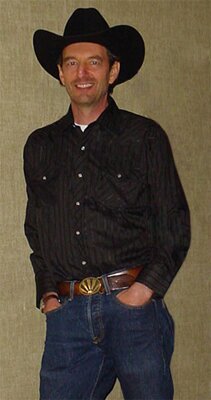Welcome to the “My Place” page
 My name is Scott My name is Scott
I run the Rope and Wire website.
My original idea for this page was to give those living in the country the opportunity to tell others about the things that made their farm or ranch so special.
Well, I’ve come to the conclusion that either no one likes to brag or no one lives on a farm or a ranch. Whatever the case, no one submitted an article so I felt it was high time to try something different.
So for now this will be literally “My Place.” I’ll use this page to post a western blog or short articles. They will either be mine, or possibly one from a contributing R&W community member.
The theme will remain Western but the content will change weekly, or there about.
If you click on any of the links to past blog's, you can return to this page by clicking on the My Place button across from my picture.
I hope you enjoy it but if not, might I suggest you “stroll the grounds.” Read a story or watch a movie.
Thanks for visiting.
Scott
The Mule
Horses have always been at the forefront of Western culture. They’re great animals for working cattle and a cowboys preferred mode of transportation.
Mules on the other hand, most people don’t think too much about mules.
At one time in this countries history, they were pretty darned important. Maybe even more important than the horse.
Admittedly they’re not as glamorous as a horse. You don’t see too many magazines out there dedicated to mules. I think the Lone Ranger and Roy Rogers would have looked awful silly riding mules. And the Kentucky Derby… it’s certainly not a mule race.
Horses have always enjoyed the spotlight while mules have always been in the background.
(Except for Francis the talking mule, but that’s another story).
And so it is with horses and mules.
The old Western movies tend to show covered wagons being pulled by horses. The truth is, during this countries Westward expansion most wagons rolling along the trail were pulled by either oxen or that ol’ beast of burden, the mule.
The best draft mules came out of Missouri. Their breeding program was darn good. Typically, a Missouri mule was a cross between a draft breed mare and a mammoth jack, which is the largest American breed of donkey. The Missouri mule was very stout and easy to manage.
During the great migration west, Missouri was a “jumping off” place where hundreds of thousands of pioneers began their journey west, with Missouri mules.
Mules were typically faster and more dependable than oxen and the ox’s split hoof had a bad tendency to splinter on the rocks in mountainous terrain.
Not exactly the best place to have “engine failure.”
By the 1870’s Missouri breeders were promoting their mules to the U.S. cotton, mining and timber industries.
Missouri mules were supplied to the British military by the hundreds of thousands during WWI and the U.S. army in WWII.
Early freight wagons were pull by teams of mules. A typical “freight train” was two or three wagons pulled by ten or more mules.
The drivers of these wagons were called “mule skinners.” They actually rode one of the mules. It was their job to keep their freight wagon under control and moving. They would guide the entire team with a single rein called a jerk line.
For a time, mules were even pulling stagecoaches, as they were more dependable and sure-footed in treacherous terrain.
Up until the early 1900’s, mules were used to plow most of the agricultural land in this country. The industrial revolution brought forth the advent of the tractor and by 1940 it had replaced most of the working mules in this country.
For the most part, horses do take center stage. They’re big, sleek, and stately and let’s not forget smart. The image of the horse was permanently cast into the minds of countless youngsters by the likes of Roy Rogers, Tom Mix, The Lone Ranger, Hopalong Cassidy and many others. While the lowly mule had only Francis (the talking mule) to boost it’s image.
Horses may get the glory but lets not forget the mule. It pulled and packed our weapons of war. It pulled our wagons across the country and pulled our plows across our fertile land. If it weren’t for this humble beast of burden, our countries history would read differently today.
***
I briefly mentioned Francis, the talking mule. I can’t in all good conscience sign off on this without at least giving equal time to the smartest and most famous of all horses, Mr. Ed. You know, the talking horse.
Willlberrr!
|